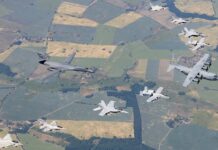The Estonian Ministry of Defence (MoD) signed a contract with Israel Aerospace Induestries (IAI) on 2 May 2023 to acquire what the Israeli company described as “long-range loitering munitions”.
The exact type of weapons procured were not disclosed, but the images accompanying an IAI press release on the development showed Mini-Harpy and Harop loitering munitions, while images on the Estonian MoD’s Twitter page appeared to show a Mini-Harpy system.
The value of the contract was also not disclosed, but IAI referred to it as “one of the most expensive defense procurement Estonia has ever made”, while Estonian Defence Minister Hanno Pevkur referred to a “nine-figure contract” on Twitter, suggesting the contract is worth at least EUR 100 M.
“Long-range loitering munitions are an important addition to the development of Estonia’s defence capability,” Pevkur was quoted as saying in a 2 May IAI press release. “The importance of indirect fire cannot be overestimated, as Russia has caused much of the destruction in Ukraine through indirect fire. The introduction of this new capability allows us to attack the enemy from a longer distance. As a result, indirect fire becomes more layered and flexible, increasing the range of fire, which means that the defence forces can hit the enemy where it hurts.”
The Mini-Harpy, which is guided by a dual electro-optical/infra-red and anti-radiation seeker, weighs 40 kg (including an 8 kg warhead), has an endurance of up to two hours and an operational range of to 100 km.
The Harop, meanwhile, first came to prominence in the April 2016 Nagorno-Karabakh conflict, when Harops deployed by Azerbaijan played havoc with Armenian columns approaching the front. They were also used effectively alongside Turkish Bayraktar TB2 armed unmanned aerial vehicles in the 2020 conflict in Nagorno-Karabakh. The Harop, which is guided by a forward-looking infra-red/colour CCD seeker, weighs around 135 kg, can carry a 16 kg warhead, has an endurance of nine hours and a communication range of 2,000 km.

The Estonian Defence Forces’ indirect-fire capability is currently provided by various-calibre mortars within manoeuvre units and self-propelled howitzers at divisional level. Multiple rocket launchers and long-range loitering munitions, however, are being in 2024-2025.
“The market for long-range loitering munitions is currently turbulent. Recent conflicts such as the Nagorno-Karabakh conflict and the ongoing war in Ukraine have demonstrated the high effectiveness of this type of offensive weapon, leading to the development of such systems by several countries, with new players expected to enter the market soon,” IAI quoted Ramil Lipp, armament category manager of the Estonian Centre for Defence Investment, as saying. “The future of this market will certainly involve intense competition, and the coming years will reveal where these systems will further evolve. Currently, we have made orders for long-range weapons which we cannot disclose the exact specifications of, but in the future we plan to acquire similar weapons with different technical capabilities and for firing at different ranges.”
The first deliveries of IAI loitering munitions to Estonia are expected to arrive in 2024. Estonian military personnel will be trained on the systems prior to this, meaning they will be able to use the systems as soon as they arrive.
Peter Felstead











